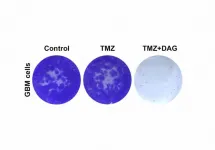(Press-News.org) A new study shows that thick sea-ice can increase the sensitivity of Greenlandic fjords to climate warming. Understanding the factors that control how fast glaciers move, break up and deposit chunks of ice (icebergs) into the fjords - and eventually the sea - is vital for predicting how the Greenland ice sheet will change under a warming climate and for predicting global rates of sea-level rise.
A new study led by Stockholm University Assistant Professor Christian Stranne, shows that thick sea-ice outside the fjords can actually increase the sensitivity of Greenlandic fjords to warming. Stranne and a team of researchers from Sweden, Greenland, the Netherlands, the USA, and Canada report on expeditions to two distinct fjords in northern Greenland during the 2015 and 2019 summers. "These fjords were practically inaccessible to researchers until quite recently because the sea-ice was too thick - they are some of the least-studied areas on the planet, and require a large icebreaker to reach them, even in the summer," says Stranne. The inaccessibility and sea-ice build-up is due to the direction of Arctic Ocean currents; the Beaufort Gyre and Transpolar Drift push ice from across the Arctic up against the northern Greenland coast.
Writing in Communications Earth & Environment, the research team report on measurements made during the Petermann 2015 and Ryder 2019 expeditions, when the Swedish icebreaker Oden made detailed studies of Petermann Fjord and Sherard Osborn Fjord in northern Greenland. Even in summer, the entrance to Sherard Osborn Fjord on the northern coast of Greenland is blocked by thick sea-ice, but the more southerly located Petermann Fjord has for several years opened to the Nares Strait, connecting the Arctic Ocean with Baffin Bay. Both fjords host large glaciers with floating ice tongues extending from Greenland glaciers many kilometers into the fjords. Unsurprisingly, warmer water temperatures will tend to melt these floating portions of the glaciers and icebergs in the fjord faster than cooler water. But how does the presence or absence of the thick sea-ice barrier outside a fjord affect water temperatures inside?
In 2019, air temperatures in northern Greenland reached record highs. Despite similar high air temperatures and conditions, Petermann Fjord's near surface sea temperatures never exceeded 0ºC. "But in the Sherard Osborn Fjord, cut off from the open ocean by thick sea-ice, near surface sea temperatures reached 4ºC - which was 3ºC higher than any previous seawater measurement north of Greenland," explains Stranne.
Summertime melt produces a warm freshwater layer floating atop saltier water in the fjord; here the sea-ice barrier trapped this meltwater inside the fjord. Because of the difference in salt content, the surface water became isolated also from the water below, allowing time for intense solar heating of the fresher surface water. Such warmer water temperatures can contribute to faster melting of the Ryder Glacier in Sherard Osborn Fjord, as well as changing the biogeochemistry in the fjord waters. Conversely, the researchers suggest, that neighboring Petermann Fjord, which was open to the sea during 2015 and 2019, experienced colder surface water temperatures because its surface water was not isolated within the fjord by a sea-ice barrier.
These observations are counterintuitive: thick sea-ice is associated with colder climates, yet it can lead to warmer surface water temperatures inside the fjords. For this reason, fjords along the northern Greenland coast are more sensitive to climate warming than fjords without a sea-ice barrier.
But each fjord is a little different. Last year, another study from the 2015 and 2019 expeditions pointed out that Ryder Glacier in Sherard Osborn Fjord is less affected by melting of the ice tongue from underneath, compared to Petermann Glacier in Petermann Fjord. In this case the explanation is not sea-ice but the shape of the seafloor that produces a shallower opening to the sea. The physical block of rock and sediment dampens intrusions of deeper warm water from outside the fjord (of Atlantic origin) which tends to make Ryder Glacier less sensitive to climate warming--while at the same time, surface sea-ice in the adjacent Lincoln Sea can make it more sensitive. "It's a complex interaction. Overall, we know that warming climate will lead to faster moving glaciers and less ice on Greenland. But how fast this happens, and to what extent, remains a key research topic," says Stranne.
INFORMATION:
Reference: Christian Stranne, Johan Nilsson, Adam Ulfsbo, Matt O'Regan, Helen K. Coxall, Lorenz Meire, Julia Muchowski, Larry A. Mayer, Volker Brüchert, Jonas Fredriksson, Brett Thornton, Julek Chawarski, Gabriel West, Elizabeth Weidner and Martin Jakobsson, The climate sensitivity of northern Greenland fjords is amplified through sea-ice damming, Communications Earth & Environment, 2021, DOI: 10.1038/s43247-021-00140-8.
Read article: https://www.nature.com/commsenv.
Contact Info:
Christian Stranne, +46-8-674 78 35 or +46-70-647 61 54, mail christian.stranne@geo.su.se
Just over half of surveyed Ontario high schools reported providing CPR and AED training to students despite being mandated by the province to provide training for the lifesaving technique, according to a new study by Unity Health Toronto researchers.
The study, published Monday April 12, in CJC Open, surveyed elementary and high schools from 15 different school boards across Ontario to understand the scope of Cardiopulmonary Resuscitation (CPR) and Automated External Defibrillator (AED) training, which are mandated in the Ontario Grade 9 Health and Physical Education Curriculum. Researchers from St. Michael's Hospital of ...
Glioblastomas are the most common and most aggressive brain tumours. Their survival rate has barely increased over the last 50 years, indicating an urgent need to develop new therapeutic strategies. In a paper published this week in the journal Molecular Cancer Therapeutics, a journal of the American Association for Cancer Research, the team led by Massimo Squatrito, Head of the Seve Ballesteros Foundation Brain Tumour Group at the Spanish National Cancer Research Centre (CNIO), proposes a novel therapeutic strategy based on the combination of temozolomide, the first-line treatment for these patients, and dianhydrogalactitol, a drug that is being tested in clinical trials and is already approved for the treatment of other ...
People who trust television and Facebook to provide them with accurate news about the coronavirus pandemic are less knowledgeable about COVID-19, according to a new study, which assessed people's knowledge of the virus in the earliest stages of the pandemic.
The study, published today in the peer-reviewed journal END ...
Researchers have found common foxgloves brought to the Americas have rapidly evolved to change flower length in the presence of a new pollinator group, hummingbirds. The findings are published in the British Ecological Society's Journal of Ecology.
Researchers from the University of Sussex, Universidad de Los Andes (Colombia) and Universidad de Costa Rica, studying the common foxglove Digitalis purpurea, a bumblebee pollinated species native to Europe, have shown for the first time how rapid physical changes can occur in flowers following a change in environment and the presence of a new pollinator.
The researchers compared foxgloves in the UK, which ...
A recent study indicates that a U.S. ban on the use of tanning beds among minors would prevent thousands of cases of melanoma in adolescents and would save millions of dollars in healthcare costs. The findings are published early online in END ...
Workplace communication often took a back seat this past year, as employees and employers rushed to work remotely, struggled with technology barriers and adjusted to physical distancing. But the pandemic has resulted in valuable lessons for communicating on the job, according to a Baylor University study.
During the onset of COVID-19 -- along with accompanying layoffs and a recession -- "there likely has never been a moment with such demand for ethical listening to employees," said lead author Marlene S. Neill, Ph.D., associate professor of journalism, public relations and new media at Baylor.
"Ethical listening" was defined by one communication ...
April12, 2021 - Gray wolves are among the largest predators to have survived the extinction at the end of the last ice age around11,700 years ago. Today, they can be found roaming Yukon's boreal forest and tundra, with caribou and moose as their main sources of food.
A new study led by the Canadian Museum of Nature shows that wolves may have survived by adapting their diet over thousands of years---from a primary reliance on horses during the Pleistocene, to caribou and moose today. The results are published in the journal Palaeogeography, Palaeoclimatology, Palaeoecology.
The research team, led by museum palaeontologist Dr. Danielle Fraser and student Zoe Landry, analysed evidence preserved in ...
HOUSTON -- Early phase clinical trials conducted by researchers from The University of Texas MD Anderson Cancer Center show promising results for patients with RET fusion-positive cancers, high-grade (HGG) and low-grade glioma (LGG) and ovarian cancer.
The results, presented today at the virtual American Association for Cancer Research (AACR) Annual Meeting 2021, showcase the researchers' ongoing efforts to advance clinical studies and expand potential indications of approved drugs to develop a platform for more effective treatments and to improve patient outcomes.
FDA-approved selpercatinib shows clinical benefits for RET fusion-positive ...
PHILADELPHIA--Giving early-stage pancreatic cancer patients a CD40 immune-stimulating drug helped jumpstart a T cell attack to the notoriously stubborn tumor microenvironment before surgery and other treatments, according to a new study from researchers in the Abramson Cancer Center (ACC) at the University of Pennsylvania. Changing the microenvironment from so-called T cell "poor" to T cell "rich" with a CD40 agonist earlier could help slow eventual progression of the disease and prevent cancer from spreading in more patients.
The data--which included 16 ...
LOS ANGELES -- Early results from a new, pioneering chimeric antigen receptor (CAR) T cell immunotherapy trial led by researchers at the UCLA Jonsson Comprehensive Cancer Center found using a bilateral attack instead of the conventional single-target approach helps minimizes treatment resistance, resulting in long-lasting remission for people with non-Hodgkin's B-cell lymphoma that has come back or has not responded to treatment.
The new approach, which will be presented at the American Association for Cancer Research Annual Meeting during one of the clinical oral plenary sessions ( END ...



